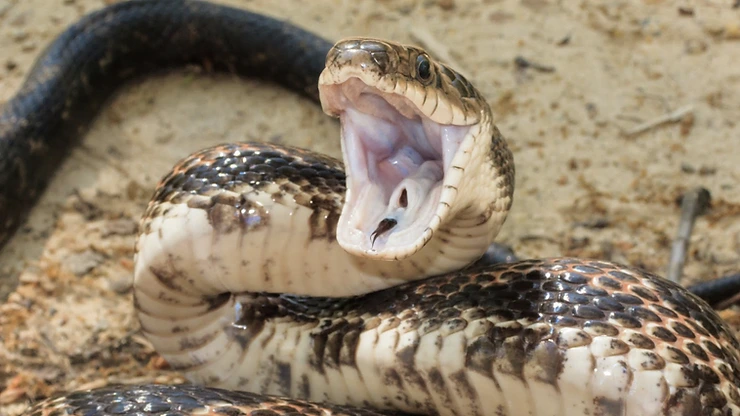When counselors and psychologists talk about anxiety that stems from a traumatic experience, it is common for us to use an example about sticks and snakes. This blog post will examine what post-traumatic stress is, a few ways it impacts us, and how you may be able to handle it. Let’s start with the sticks and snakes:
Imagine that you are a hiker. You spend lots of time on trails that weave through the woods and you deeply enjoy natural settings. You feel safe there and connected to the Earth. You see sticks on the ground every hike, along with vines and branches and flowers and rocks and all other elements of nature. You love it. One day, though, you see what you think is a stick in front of you – but all of a sudden it lunges toward you! It curls up and strikes violently! You narrowly avoid a trip to the hospital as it misses your leg and its fangs hit your boot instead. You run away, out of breath and terrified. You’d like to think it’s over, but the experience has left its mark internally. You don’t want to go hiking anymore. You try walking around your yard at home and see a stick – but now it looks like a snake! ALL the sticks look like snakes! You stop hiking. You can’t enjoy it anymore, because you feel like you have to be on high-alert every time you see a stick.
This example describes post-traumatic stress symptoms, particularly anxiety, hypervigilance, and physiological arousal from triggers. But what is this phenomenon that we often loosely abbreviate to “trauma”? Simply put, a traumatic event is any event in which we feel like our physical, emotional, or spiritual safety is threatened and leads us to have anxiety or depression, to re-experience the event, to have nightmares, to have a physiological response, or to overly protect ourselves from the event’s recurrence. (There are more symptoms, but these are among the most common.) It is also important to clarify that a traumatic event doesn’t have to seem to others like it should have been traumatic to us. A traumatic event is any event that the victim perceives as traumatic. No one gets to say what was and wasn’t traumatic for another person.
In 2014, a book was released on the topic of post-traumatic stress called The Body Keeps The Score. It’s academic, like a textbook, and kind of a painful, tedious read. But one of the main concepts expressed in the book is that the lingering effects of trauma live in the body as much or more than the brain. Trauma impacts the nervous system, causing tremendous anxiety when it’s memory is triggered. A full-on high-alert stage is reached within our bodies, often without our brains even realizing what is going on until afterward. Here’s some more of my patented “Neurology For Dummies”, a phrase I coined as a “dummy” myself about neurology: (Hint: It’s not really patented.)
We know that the amygdala is alerted in the brain before an aroused trauma response. The amygdala is a very basic and self-protective portion of the brain that is responsible for keeping us safe. Our internal wiring prioritizes safety, so when we feel threatened, we go right into a bodily response rather than try to think our way through it logically. Thinking may take too much time, so our response bypasses the part of the brain that thinks more deeply and logically. When a snake strikes, we don’t have time to think, only to jump back. This keeps us safe in the moment, but after the fact, it can cause problems. The amygdala can get alerted by seeing a stick (a trigger) and tell the body it’s a snake (threat), resulting in an escalated fight-flight-freeze response. You can see how this can cause problems!
Much of what we know about the effects of trauma comes from veterans who have returned from war zones. Now back in the comfort of their homes and their families, they may still have many symptoms of post-traumatic stress. Veterans who have served as drivers in areas where improvised explosive devices (IED’s) were common were often trained to swerve to avoid any bottle or trash on the side of the road. This caused multiple wrecks upon their return when they found themselves swerving to miss an innocent Coke bottle or other litter back in the USA. All the litter looks like an IED. All the sticks look like snakes. We owe our veterans an enormous debt of gratitude for what they have endured for our protection. Thank you to all current and former military personnel!
You don’t have to have military experience to have been impacted by trauma. It’s a normal and natural human response to significant distressing events. It is not shameful or a sign of weakness or wrongness. Here’s what you can possibly do to help mitigate the symptoms. (See important note below.) Remember how trauma bypasses the part of our brain that gives us higher logical thought? We’ve got to engage that part to help us through physiologically aroused responses. So, when all the sticks look like snakes, it’s time to remind ourselves of the truth: This situation isn’t the old situation. Today isn’t yesterday. Here isn’t there. I’m not back there in that old situation. I’m here in this moment today. I’m safe.
One of the most difficult things about managing traumatic stress is often realizing when it is occurring. So, before I can tell myself the truth, I may have to first identify that I’m feeling the anxiety. This starts with first identifying how my body feels when it’s anxious or distressed. Where do the symptoms show up? Maybe I get a headache or muscle pains. Maybe my stomach feels uneasy or I get a random pain somewhere in my body. It could be in the form of tension in my forehead or an unpleasant sensation elsewhere. It could be anything and anywhere. But once I have identified where my body shows the anxiety, I can better identify when I’m feeling anxious. Then I can use a coping skill to reduce the impact. One of the most common and easiest coping skills for post-traumatic distress is to take long slow deep breaths, in through the nose and out through the mouth. Various versions of this technique involve breathing in for a number of seconds, holding a few seconds, then breathing out for a number of seconds. Personally, I like to breathe in for 4 seconds and out for 8. Other helpful coping skills are working out and running or walking. These particular coping skills access the fight-or-flight energy and reduce it by using it. Literally engaging in fight-or-flight motions such as pushing things away in a workout or foot travel uses the stress up in a way that is natural and healthy for us. Some may even use a punching bag or scream into a pillow to safely vent the “fight” energy. Remember, too, that it’s OK to feel anyway that you feel. It’s just not OK to do or say anything destructive because of the feeling. But you can strap on your boxing gloves and hit a bag all day without hurting anyone.
Click here for more information on how we treat Anxiety, ADHD, Autism, or to learn more about our services in general
I hope this post has been informative and helpful. I do not specialize in treating post-traumatic stress disorder, but all of us counselors have to understand the basics of this phenomenon. It’s a part of every client’s life, and it’s a part of every human’s condition. If you’d like to speak more about this or other types of symptoms, please give me a call at 770 615 6300. You can also schedule a session and learn more about my practice at www.altmancounseling.com If your trauma symptoms linger or are severe in nature, please seek help and see below.
IMPORTANT: If you are having significant symptoms that involve thoughts of harming yourself or others, it is important that you receive emergency attention immediately by going to an emergency room, calling 9-1-1, or calling 9-8-8 for Georgia residents



0 Comments